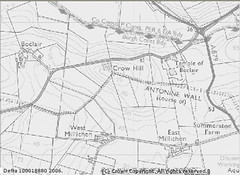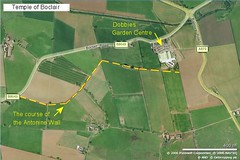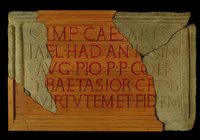It is well-known that the Romans painted their statuary.
And they may have had a penchant for bright colors. For example, it has been suggested that Hadrian's Wall was whitewashed, and the joints between the stone blocks picked out in red mortar. But I recently came across the ultimate in garish decor.
First, some background. The construction of the Forth & Clyde canal in the 1770s, broadly following the ancient line of the Antonine Wall, uncovered various decorative stone slabs now known as "Distance Slabs" (because their purpose was to record the various lengths of wall completed by the different legionary work gangs). Agricultural activity periodically turned up additional slabs, so that 20 are now known, each one different.
In 1865 (according to Lawrence Keppie's Roman Inscribed and Sculptured Stones in the Hunterian Museum), a splendid example was unearthed near Bearsden, and was sold for £2 to a Glasgow lawyer. When Glasgow University declined to purchase the slab from him, it was sold to the American consul and shipped to Chicago!
But, before you cry out for the rendition and repatriation of such an important antiquity, there's bad news. For the slab was lost, presumed destroyed, in the great fire of Chicago in 1871.
Thankfully, the great Hadrian's Wall scholar, John Collingwood Bruce, had the foresight to order several plaster casts of the slab before it departed; which brings us back to the subject of decor.
The ghastly purple slab illustrated here is, in fact, one of these plaster casts, deposited in the Grosvenor Museum at Chester. Whether the Romans would, in fact, have used this color scheme is unknown. My own preference is for the example still to be seen in the Hunterian Museum (Glasgow), which has been rendered in altogether more sobre tones.




